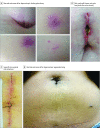Evaluation of Wound Photography for Remote Postoperative Assessment of Surgical Site Infections
- PMID: 30422236
- PMCID: PMC6439665
- DOI: 10.1001/jamasurg.2018.3861
Evaluation of Wound Photography for Remote Postoperative Assessment of Surgical Site Infections
Abstract
Importance: Surgeons are increasingly interested in using mobile and online applications with wound photography to monitor patients after surgery. Early work using remote care to diagnose surgical site infections (SSIs) demonstrated improved diagnostic accuracy using wound photographs to augment patients' electronic reports of symptoms, but it is unclear whether these findings are reproducible in real-world practice.
Objective: To determine how wound photography affects surgeons' abilities to diagnose SSIs in a pragmatic setting.
Design, setting, and participants: This prospective study compared surgeons' paired assessments of postabdominal surgery case vignettes with vs without wound photography for detection of SSIs. Data for case vignettes were collected prospectively from May 1, 2007, to January 31, 2009, at Erasmus University Medical Center, Rotterdam, the Netherlands, and from July 1, 2015, to February 29, 2016, at Vanderbilt University Medical Center, Nashville, Tennessee. The surgeons were members of the American Medical Association whose self-designated specialty is general, abdominal, colorectal, oncologic, or vascular surgery and who completed internet-based assessments from May 21 to June 10, 2016.
Intervention: Surgeons reviewed online clinical vignettes with or without wound photography.
Main outcomes and measures: Surgeons' diagnostic accuracy, sensitivity, specificity, confidence, and proposed management with respect to SSIs.
Results: A total of 523 surgeons (113 women and 410 men; mean [SD] age, 53 [10] years) completed a mean of 2.9 clinical vignettes. For the diagnosis of SSIs, the addition of wound photography did not change accuracy (863 of 1512 [57.1%] without and 878 of 1512 [58.1%] with photographs). Photographs decreased sensitivity (from 0.58 to 0.50) but increased specificity (from 0.56 to 0.63). In 415 of 1512 cases (27.4%), the addition of wound photography changed the surgeons' assessment (215 of 1512 [14.2%] changed from incorrect to correct and 200 of 1512 [13.2%] changed from correct to incorrect). Surgeons reported greater confidence when vignettes included a wound photograph compared with vignettes without a wound photograph, regardless of whether they correctly identified an SSI (median, 8 [interquartile range, 6-9] vs median, 8 [interquartile range, 7-9]; P < .001) but they were more likely to undertriage patients when vignettes included a wound photograph, regardless of whether they correctly identified an SSI.
Conclusions and relevance: In a practical simulation, wound photography increased specificity and surgeon confidence, but worsened sensitivity for detection of SSIs. Remote evaluation of patient-generated wound photographs may not accurately reflect the clinical state of surgical incisions. Effective widespread implementation of remote postoperative assessment with photography may require additional development of tools, participant training, and mechanisms to verify image quality.
Conflict of interest statement
Figures


Comment in
-
Smartphone Photographs-Proceed, but With Caution.JAMA Surg. 2019 Feb 1;154(2):125. doi: 10.1001/jamasurg.2018.3862. JAMA Surg. 2019. PMID: 30422237 No abstract available.

